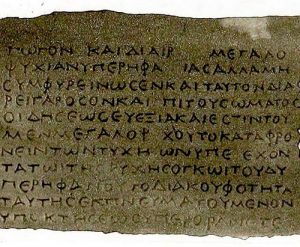New analysis of Herculaneum papyrus scroll fragments revealed the use of metallic ink in Greco-Roman literary inscription centuries earlier than previously thought. Texts from antiquity, particularly Greek and Latin literary manuscripts produced until the fourth century AD, were largely written in carbon-based ink on papyri.

Nondestructive synchrotron X-ray-based methods of chemical analysis of the barely visible black inscriptions on two nearly flat, multi-layered papyrus fragments that were found at the Villa dei Papiri at Herculaneum in the mid-18th century provided information that both pieces contained high lead concentrations — around 84 µg/cm2 and 16 µg/cm2. Such amount rules out contamination from aqueducts, inkpots, or containers and pushes back by several centuries the advent of metallic ink for literary inscription. Until now it was believed that the introduction of metal in writing materials is dated to fourth-fifth century AD.
(after Popular Archaeology)